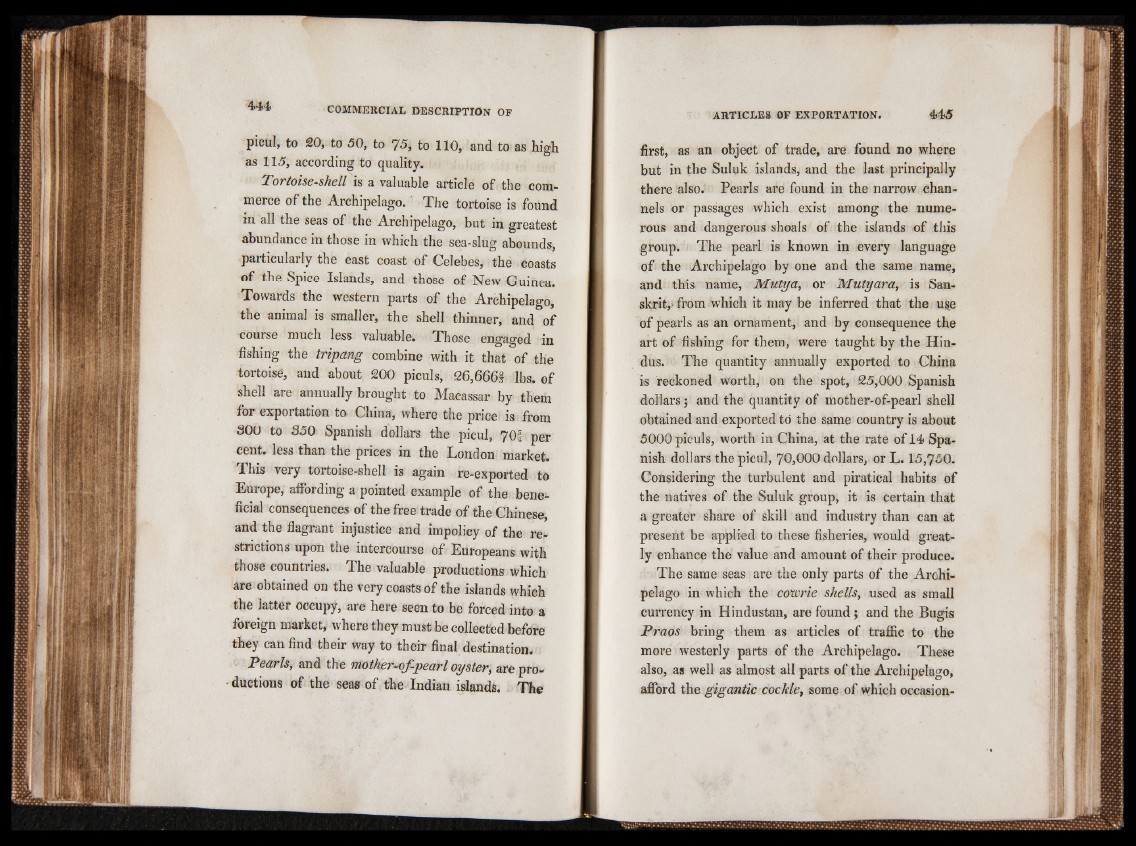
picul, to 20, to 50, to 15, to 110, and to as high
as 115, according to quality.
Tottoise-shell is a valuable article of the commerce
of the Archipelago.- The tortoise is found
in all the seas of the Archipelago, but in greatest
abundance in those in which the sea-slug abounds,
particularly the east coast of Celebes, the coasts
of the. Spice Islands, and those of New Guinea.
Towards the western parts of the Archipelago,
the animal is smaller, the shell thinner, and of
course much less valuable. Those engaged in
fishing the tripang combine with it that of the
tortoise, and about 200 piculs, 26,666§ lbs. of
shell are annually brought to Macassar by them
for exportation to Cmna, where the price is from
300 to 350 Spanish dollars the picul, 70 | per
cent, less than the prices in the London market.
This very tortoise-shell is again re-exported to
Europe, affording a pointed example of the beneficial
consequences of the free trade of the Chinese,
and the flagrant injustice and impolicy of the restrictions
upon the intercourse of Europeans with
those countries. The valuable productions which
are obtained on the very coasts of the islands which
the latter occupy, are here seen to be forced into a
foreign market, where they must be collected before
they can find their way to their final destination.
Pearls, and the mother-of-pearl oyster, are productions
of the seas of the Indian islands. The
first, as an object of trade, are found no where
but in the Suluk islands, and the last principally
there also.! Pearls are found in the narrow channels
or passages which exist among the numerous
and dangerous shoals of the islands of this
group. The pearl is known in every language
of the Archipelago by one and the same name,
and this name, Mutya, or Mutyara, is Sanskrit,
» from which it may be inferred that the usie
of pearls as an ornament, and by consequence the
art of fishing for them, were taught by the Hindus.
The quantity annually exported to China
is reckoned worth, on the spot, 25,000 Spanish
dollars 5 and the quantity of mother-of-pearl shell
obtained and exported to the same country is about
5000 piculs, worth in China, at the rate of 14 Spanish
dollars the picul, 70,000 dollars, or L. 15,750.
Considering the turbulent and piratical habits of
the natives of the Suluk group, it is certain that
a greater share of skill and industry than can at
present be applied to these fisheries, would greatly
enhance the value and amount of their produce.
The same seas are the only parts of the Archipelago
in which the cowrie shells, used as small
currency in Hindustan, are found; and the Bugis
Praos bring them as articles of traffic to the
more westerly parts of the Archipelago. These
also, as well as almost all parts of the Archipelago,
afford the gigantic cockle, some of which occasion